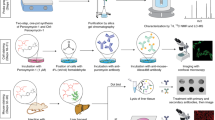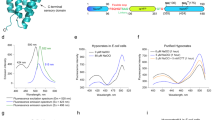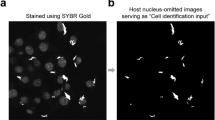Abstract
Phagocytes destroy pathogens by trapping them in a transient organelle called the phagosome, where they are bombarded with reactive oxygen species (ROS) and reactive nitrogen species (RNS). Imaging reactive species within the phagosome would directly reveal the chemical dynamics underlying pathogen destruction. Here we introduce a fluorescent, DNA-based combination reporter, cHOClate, which simultaneously images hypochlorous acid (HOCl) and pH quantitatively. Using cHOClate targeted to phagosomes in live cells, we successfully map phagosomal production of a specific ROS, HOCl, as a function of phagosome maturation. We found that phagosomal acidification was gradual in macrophages and upon completion, HOCl was released in a burst. This revealed that phagosome–lysosome fusion was essential not only for phagosome acidification, but also for providing the chloride necessary for myeloperoxidase activity. This method can be expanded to image several kinds of ROS and RNS and be readily applied to identify how resistant pathogens evade phagosomal killing.
This is a preview of subscription content, access via your institution
Access options
Access Nature and 54 other Nature Portfolio journals
Get Nature+, our best-value online-access subscription
$29.99 / 30 days
cancel any time
Subscribe to this journal
Receive 12 print issues and online access
$259.00 per year
only $21.58 per issue
Buy this article
- Purchase on Springer Link
- Instant access to full article PDF
Prices may be subject to local taxes which are calculated during checkout




Similar content being viewed by others
Data availability
The data that support the plots within this paper and other findings of this study are available from the corresponding authors upon reasonable request.
References
Chernyak, L. & Tauber, A. I. The birth of immunology: Metchnikoff, the embryologist. Cell. Immunol. 117, 218–233 (1988).
Robinson, J. M. Reactive oxygen species in phagocytic leukocytes. Histochem. Cell Biol. 130, 281–297 (2008).
Winterbourn, C. C. & Kettle, A. J. Redox reactions and microbial killing in the neutrophil phagosome. Antioxid. Redox Signal. 18, 642–660 (2013).
Segal, A. W. How neutrophils kill microbes. Annu. Rev. Immunol. 23, 197–223 (2005).
Bhavsar, A. P., Guttman, J. A. & Finlay, B. B. Manipulation of host-cell pathways by bacterial pathogens. Nature 449, 827–834 (2007).
Klebanoff, S. J., Kettle, A. J., Rosen, H., Winterbourn, C. C. & Nauseef, W. M. Myeloperoxidase: a front-line defender against phagocytosed microorganisms. J. Leukoc. Biol. 93, 185–198 (2013).
Hampton, M. B., Kettle, A. J. & Winterbourn, C. C. Inside the neutrophil phagosome: oxidants, myeloperoxidase, and bacterial killing. Blood 92, 3007–3017 (1998).
Aratani, Y. Myeloperoxidase: Its role for host defense, inflammation, and neutrophil function. Arch. Biochem. Biophys. 640, 47–52 (2018).
Klebanoff, S. J. Myeloperoxidase: friend and foe. J. Leukoc. Biol. 77, 598–625 (2005).
Chen, J. W., Breckwoldt, M. O., Aikawa, E., Chiang, G. & Weissleder, R. Myeloperoxidase-targeted imaging of active inflammatory lesions in murine experimental autoimmune encephalomyelitis. Brain 131, 1123–1133 (2008).
Pulli, B. et al. Measuring myeloperoxidase activity in biological samples. PLoS One 8, e67976 (2013).
Robaszkiewicz, A., Bartosz, G. & Soszynski, M. Detection of 3-chlorinated tyrosine residues in human cells by flow cytometry. J. Immunol. Methods 369, 141–145 (2011).
Xu, Q. et al. A highly specific fluorescent probe for hypochlorous acid and its application in imaging microbe-induced HOCl production. J. Am. Chem. Soc. 135, 9944–9949 (2013).
Shepherd, J. et al. A fluorescent probe for the detection of myeloperoxidase activity in atherosclerosis-associated macrophages. Chem. Biol. 14, 1221–1231 (2007).
Oushiki, D. et al. Development and application of a near-infrared fluorescence probe for oxidative stress based on differential reactivity of linked cyanine dyes. J. Am. Chem. Soc. 132, 2795–2801 (2010).
Lou, Z., Li, P., Song, P. & Han, K. Ratiometric fluorescence imaging of cellular hypochlorous acid based on heptamethine cyanine dyes. Analyst 138, 6291–6295 (2013).
Sun, M. et al. Oxidative cleavage-based near-infrared fluorescent probe for hypochlorous acid detection and myeloperoxidase activity evaluation. Anal. Chem. 86, 671–677 (2014).
Kenmoku, S., Urano, Y., Kojima, H. & Nagano, T. Development of a highly specific rhodamine-based fluorescence probe for hypochlorous acid and its application to real-time imaging of phagocytosis. J. Am. Chem. Soc. 129, 7313–7318 (2007).
Saha, S., Prakash, V., Halder, S., Chakraborty, K. & Krishnan, Y. A pH-independent DNA nanodevice for quantifying chloride transport in organelles of living cells. Nat. Nanotechnol. 10, 645–651 (2015).
Modi, S. et al. A DNA nanomachine that maps spatial and temporal pH changes inside living cells. Nat. Nanotechnol. 4, 325–330 (2009).
Chakraborty, K., Leung, K. & Krishnan, Y. High lumenal chloride in the lysosome is critical for lysosome function. eLife 6, e28862 (2017).
Sharma, S., Zaveri, A., Visweswariah, S. S. & Krishnan, Y. A fluorescent nucleic acid nanodevice quantitatively images elevated cyclic adenosine monophosphate in membrane-bound compartments. Small 10, 4276–4280 (2014).
Surana, S., Bhat, J. M., Koushika, S. P. & Krishnan, Y. An autonomous DNA nanomachine maps spatiotemporal pH changes in a multicellular living organism. Nat. Commun. 2, 340 (2011).
Chakraborty, K., Veetil, A. T., Jaffrey, S. R. & Krishnan, Y. Nucleic acid-based nanodevices in biological imaging. Annu. Rev. Biochem. 85, 349–373 (2016).
Panchuk-Voloshina, N. et al. Alexa dyes, a series of new fluorescent dyes that yield exceptionally bright, photostable conjugates. J. Histochem. Cytochem. 47, 1179–1188 (1999).
Nüsse, O. Biochemistry of the phagosome: the challenge to study a transient organelle. ScientificWorldJournal 11, 2364–2381 (2011).
Yeung, T., Touret, N. & Grinstein, S. Quantitative fluorescence microscopy to probe intracellular microenvironments. Curr. Opin. Microbiol. 8, 350–358 (2005).
King, C. C., Jefferson, M. M. & Thomas, E. L. Secretion and inactivation of myeloperoxidase by isolated neutrophils. J. Leukoc. Biol. 61, 293–302 (1997).
Canton, J., Khezri, R., Glogauer, M. & Grinstein, S. Contrasting phagosome pH regulation and maturation in human M1 and M2 macrophages. Mol. Biol. Cell 25, 3330–3341 (2014).
Yuan, L., Lin, W. & Feng, Y. A rational approach to tuning the pKa values of rhodamines for living cell fluorescence imaging. Org. Biomol. Chem. 9, 1723–1726 (2011).
Underhill, D. M. Macrophage recognition of zymosan particles. J. Endotoxin Res. 9, 176–180 (2003).
Ohno, N. et al. Inflammatory and immunopharmacological activities of meta-periodate oxidized zymosan. Zentralbl. Bakteriol. 289, 63–77 (1999).
Zimmerman, J. F. et al. Cellular uptake and dynamics of unlabeled freestanding silicon nanowires. Sci. Adv. 2, e1601039 (2016).
Di, A. et al. CFTR regulates phagosome acidification in macrophages and alters bactericidal activity. Nat. Cell Biol. 8, 933–944 (2006).
Champion, J. A., Walker, A. & Mitragotri, S. Role of particle size in phagocytosis of polymeric microspheres. Pharm. Res. 25, 1815–1821 (2008).
Jiang, L. et al. Intracellular chloride channel protein CLIC1 regulates macrophage function through modulation of phagosomal acidification. J. Cell Sci. 125, 5479–5488 (2012).
Aiken, M. L., Painter, R. G., Zhou, Y. & Wang, G. Chloride transport in functionally active phagosomes isolated from human neutrophils. Free Radic. Biol. Med. 53, 2308–2317 (2012).
Hackam, D. J. et al. Regulation of phagosomal acidification. Differential targeting of Na+/H+ exchangers, Na+/K+-ATPases, and vacuolar-type H+-atpases. J. Biol. Chem. 272, 29810–29820 (1997).
Odobasic, D., Kitching, A. R. & Holdsworth, S. R. Neutrophil-mediated regulation of innate and adaptive immunity: the role of myeloperoxidase. J. Immunol. Res. 2016, 2349817 (2016).
McMillen, T. S., Heinecke, J. W. & LeBoeuf, R. C. Expression of human myeloperoxidase by macrophages promotes atherosclerosis in mice. Circulation 111, 2798–2804 (2005).
Brennan, M. L. et al. Increased atherosclerosis in myeloperoxidase-deficient mice. J. Clin. Invest. 107, 419–430 (2001).
de Morais, N. G., da Costa, T. B., de Almeida, T. M., Severo, M. S. & de Castro, C. M. M. B. Immunological parameters of macrophages infected by methicillin resistant/sensitive Staphylococcus aureus. J. Bras. Patol. Med. Lab. 49, 84–90 (2013).
Tlili, A., Dupré-Crochet, S., Erard, M. & Nüsse, O. Kinetic analysis of phagosomal production of reactive oxygen species. Free Radic. Biol. Med. 50, 438–447 (2011).
VanderVen, B. C., Yates, R. M. & Russell, D. G. Intraphagosomal measurement of the magnitude and duration of the oxidative burst. Traffic 10, 372–378 (2009).
Wong, C.-O. et al. Lysosomal degradation is required for sustained phagocytosis of bacteria by macrophages. Cell Host Microbe 21, 719–730.e6 (2017).
Chan, J., Dodani, S. C. & Chang, C. J. Reaction-based small-molecule fluorescent probes for chemoselective bioimaging. Nat. Chem. 4, 973–984 (2012).
Strzepa, A., Pritchard, K. A. & Dittel, B. N. Myeloperoxidase: a new player in autoimmunity. Cell. Immunol. 317, 1–8 (2017).
Al-Amran, F. F. & Shahkolahi, M. Oxytocin ameliorates the immediate myocardial injury in heart transplant through down regulation of the neutrophil dependent myocardial apoptosis. Heart Views 15, 37–45 (2014).
Kumar, A. P. & Reynolds, W. F. Statins downregulate myeloperoxidase gene expression in macrophages. Biochem. Biophys. Res. Commun. 331, 442–451 (2005).
Michalski, R., Zielonka, J., Hardy, M., Joseph, J. & Kalyanaraman, B. Hydropropidine: a novel, cell-impermeant fluorogenic probe for detecting extracellular superoxide. Free Radic. Biol. Med. 54, 135–147 (2013).
Setsukinai, K., Urano, Y., Kakinuma, K., Majima, H. J. & Nagano, T. Development of novel fluorescence probes that can reliably detect reactive oxygen species and distinguish specific species. J. Biol. Chem. 278, 3170–3175 (2003).
Lin, V. S., Dickinson, B. C. & Chang, C. J. Boronate-based fluorescent probes: imaging hydrogen peroxide in living systems. Methods Enzymol. 526, 19–43 (2013).
Robinson, K. M. & Beckman, J. S. Synthesis of peroxynitrite from nitrite and hydrogen peroxide. Methods Enzymol. 396, 207–214 (2005).
Abo, M. et al. Development of a highly sensitive fluorescence probe for hydrogen peroxide. J. Am. Chem. Soc. 133, 10629–10637 (2011).
Kratz, M. et al. Metabolic dysfunction drives a mechanistically distinct proinflammatory phenotype in adipose tissue macrophages. Cell Metab. 20, 614–625 (2014).
Becker, L. et al. Unique proteomic signatures distinguish macrophages and dendritic cells. PLoS One 7, e33297 (2012).
Zhang, X., Goncalves, R. & Mosser, D. M. The isolation and characterization of murine macrophages. Curr. Protoc. Immunol. Chapter 14, Unit14.1 (2008).
Veetil, A. T., Jani, M. S. & Krishnan, Y. Chemical control over membrane-initiated steroid signaling with a DNA nanocapsule. Proc. Natl. Acad. Sci. USA 115, 9432–9437 (2018).
Acknowledgements
We thank V. Rawal and A.T. Veetil for valuable discussions, D. Nelson (Department of Pharmacological and Physiological Sciences, the University of Chicago) and C.A. Petersen (Department of Epidemiology, College of Public Health, University of Iowa) for providing macrophage cell lines, A. Hoffman and K. Schoenfelt (Ben May Department for Cancer Research, The University of Chicago, Chicago, IL, USA) for providing primary macrophages, blood donors and K.M. Becker for help with blood draws, M. Zajac and K. Chakraborty for manuscript editing and the Integrated Light Microscopy facility at the University of Chicago. This work was supported by the University of Chicago Women’s Board, Pilot and Feasibility award from an NIDDK center grant P30DK42086 to the University of Chicago Digestive Diseases Research Core Center, R01 DK102960, MRSEC grant no. DMR-1420709, and University of Chicago start-up funds to Y.K. Pilot funding from the Biological Sciences Division to Y.K. and L.B. Y.K. is a Brain Research Foundation Fellow.
Author information
Authors and Affiliations
Contributions
S.T. and Y.K. designed the project. S.T. and K.D. performed chemical synthesis. S.T. synthesized and characterized the sensor. C.C. and G.Z. isolated and characterized primary cells from human and mice. M.S.J. contributed immunostaining and western blot expertise. S.T. and M.S.J. performed imaging experiments. S.T., M.S.J., L.B. and Y.K. analyzed the data. S.T. and Y.K. wrote the paper. All authors discussed the results and gave inputs on the manuscript.
Corresponding authors
Ethics declarations
Competing interests
The authors declare no competing interests.
Additional information
Publisher’s note: Springer Nature remains neutral with regard to jurisdictional claims in published maps and institutional affiliations.
Supplementary information
Supplementary Information
Supplementary Tables 1–2, Supplementary Figures 1–19
Supplementary Video 1
Heat maps of phagosome acidification using z-cHOClate in G/B channel, as a function of time. Particles outside the cell have lower G/B (Blue), whereas particles inside the matured phagosome (white arrow) have higher G/B (red). Movie is played at 1 fps speed, and representative data from three independent experiments are shown.
Supplementary Video 2
Heat maps of HOCl production in the phagosome using z-cHOClate in R/B channel, as a function of time. Particles outside the cell show higher R/B (red), whereas particles inside the matured phagosome (white arrow) have lower R/B (blue). Movie is played at 1 fps speed, and representative data from three independent experiments are shown.
Supplementary Video 3
Heat maps of phagosome acidification in the phagosome using z-cHOClate in J774A.1 cells pretreated with ABAH (100 mM), visualized using the G/B channel. Particles outside the cell have lower G/B (Blue), whereas particles inside the matured phagosome (white arrow) have higher G/B (red), indicating that acidification is not hampered. Movie is played at 1 fps speed, and representative data from three independent experiments are shown.
Supplementary Video 4
Heat maps of HOCl production in the phagosome of J774A.1 cells pretreated with ABAH (100 mM), visualized using R/B channel. Particles outside the cell as well as particles inside the matured phagosome (white arrow) show higher R/B (red), indicating that z-cHOClate is sensing HOCl specifically in the R/B channel. Movie is played at 1 fps speed, and representative data from three independent experiments are shown.
Supplementary Note 1
Synthetic procedures
Rights and permissions
About this article
Cite this article
Thekkan, S., Jani, M.S., Cui, C. et al. A DNA-based fluorescent reporter maps HOCl production in the maturing phagosome. Nat Chem Biol 15, 1165–1172 (2019). https://doi.org/10.1038/s41589-018-0176-3
Received:
Accepted:
Published:
Issue Date:
DOI: https://doi.org/10.1038/s41589-018-0176-3
This article is cited by
-
Fe-doped carbon dots: a novel fluorescent nanoprobe for cellular hypochlorous acid imaging
Analytical Sciences (2024)
-
Recent advance in dual-functional luminescent probes for reactive species and common biological ions
Analytical and Bioanalytical Chemistry (2022)
-
A DNA-based voltmeter for organelles
Nature Nanotechnology (2021)
-
Organelle-level precision with next-generation targeting technologies
Nature Reviews Materials (2021)
-
A DNA-based fluorescent probe maps NOS3 activity with subcellular spatial resolution
Nature Chemical Biology (2020)



